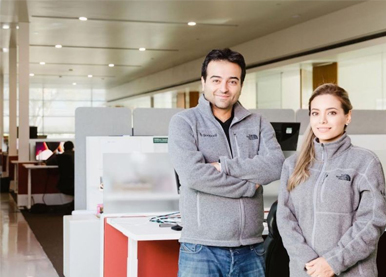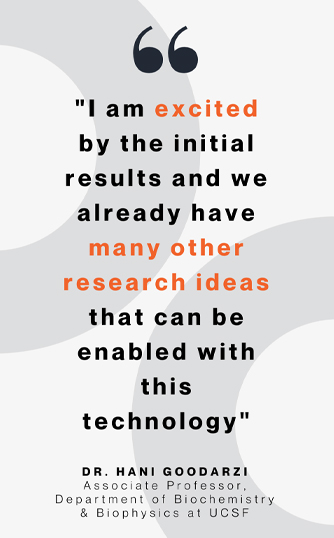For us at Deepcell and our collaborators, 2022 was a big year. From presenting our scientific findings at 5 different conferences, being listed as a top AI company by Forbes, and launching our Technology Access Program, 2022 showcased the keen interest that scientists have in Deepcell’s technology. Now, we are focused on getting this technology into the hands of users so more breakthrough discoveries can be made. As we head into the next big year for Deepcell, we want to take a moment and remind ourselves how it all began and what exciting adventures await in 2023 and beyond.
The Founding of Deepcell

Spun out of Stanford University in 2017, Deepcell was founded by scientists for scientists, on the premise of combining advances in AI, microfluidics, and high-resolution optics to deliver novel biological insights distinctively through the lens of cell morphology. As a postdoctoral researcher, Deepcell CEO Maddison Masaeli was studying the function of cardiomyocytes associated with disease. Her approach to phenotyping was primarily based on visual interpretations of morphology. Questioning whether there was a way to broadly automate the phenotyping of individual cells in real-time and capture cells based on those phenotypes, Masaeli co-founded the company together with Mahyar Salek, a computer scientist with a track record of building products with data and machine learning at their cores. Euan Ashley, Masaeli’s postdoctoral advisor, joined the duo as the scientific co-founder. “From its early days in my lab to its launch as a startup, the Deepcell technology has offered the exciting potential of characterizing, identifying, and sorting cells without perturbation,” said Euan Ashley, Professor at Stanford and Advisory Board Member at Deepcell.
Clinical use cases such as non-invasive prenatal testing, where the Deepcell technology is uniquely poised to capture free circulating fetal cells from maternal plasma were the initial aspirations. However, early collaborator interest in an extensive swath of applications crystallized the idea that the technology ought to be put in the hands of a broad number of scientists to accelerate biological discoveries.
And the community agreed. Coming off of a $20 million Series A in late 2020, the focus centralized on collaborating with a select number of scientists to demonstrate the use cases for single cell morphology. “Our collaborators demonstrated the unbounded potential for AI to look at many dimensions of cell morphology in a hypothesis-free manner, meaning you can look at differences in cell morphology without a specific marker for them. It means scientists are unbounded in their ability to interrogate more attributes of cells,” says Marc Montserrat about the initial scientific collaborations.
What does the community see in Deepcell?

Cell morphology is the gold standard for pathology and cytology, and more broadly as a bedrock for cell classification. However, while life science tools companies have seen staggering growth in the various omics – genomics, transcriptomics, proteomics, and metabolomics – there is a noticeable lack of understanding of cell morphology as an “ome” (i.e. high-dimensional, quantitative, objective) . Therefore, the concept of the Deepcell platform to bring additional quantitative interpretability to single cell analysis seemed promising. The Series A funding round in 2020 provided the funds to develop the initial proof of concept platform and evaluate the data type. As data began to flow and be presented at scientific conferences such as the American Society for Cell Biology (ASCB), interest from collaborators grew. It became apparent that the Deepcell platform has great potential for transforming the way cell morphology is analyzed and combined with other -omic modalities. To accelerate the scaling of operations and market introduction of the platform, a $73 million Series B round of funding came to fruition in early 2022. With the additional funding, we saw the Deepcell leadership team grow across marketing, support, operations, and people to support the growing interest in the platform and ultimately, the launch of our Technology Access Program. The program, in which we partner with top scientists at institutions all over the world to apply morpholomic data to their biological questions, has seen promising initial results. With collaborators studying various cell types and states, such as pigmentation in melanoma and drug treatment in lymphoblasts, their excitement is palpable. Dr. Hani Goodarzi, Associate Professor Department of Biochemistry & Biophysics at UCSF shared, “Using Deepcell technology, we aim to study time-course morphological changes in drugged lymphoblast cells. This would allow us to understand drug response and efficacy in ways that was not possible before. I am excited by the initial results and we already have many other research ideas that can be enabled with this technology.”
The Next Step – providing scientists access to the platform
So what’s next for Deepcell? The theme for 2023 is expansion – expanding awareness of a new modality for quantifying high-dimensional morphological data known as morpholomics, and expanding the availability of the technology to new users. Having launched our Technology Access Program in 2022 with instruments at TGen and UCSF, we are excited to add additional sites to the program and make the platform more broadly available later in the year. Be on the lookout for our expanded presence at conferences, such as AGBT, SLAS, AACR, and CYTO, and exciting data releases.
Interested in trying the platform out yourself? Get in touch!
—
Intrigued by what you read? Join our email list to stay informed about the applications of high-dimensional morphology data.

Michelle Balakrishnan
Sr. Product Marketing Manager - Deepcell



